Solar Web
- Lesson Plan
- Feedback Form
How do animals and plants survive on Earth? By utilizing the sun’s energy! In this fun activity students will create a “solar web” to visualize how the sun’s energy is the basis for life on Earth.
SEED Standard 5.3.2
Obtain, evaluate, and communicate information that animals obtain energy and matter from the food they eat for body repair, growth, and motion and to maintain body warmth. Emphasize that the energy used by animals was once energy from the Sun.
Materials
• 1 or 2 balls of yarn (depending if you choose to make one or two circles)
• 1 scissor
• Printed pictures of sun, plants and animals (see attachment)
• Tape or clothes pins to attach pictures to clothing
• Space for the class to form a large circle (outside is best)
Background
Living things need energy to survive. All living things get energy from food. Green plants use energy from the sun to survive. Animals get energy by eating plants and/ or other animals. The energy in living things originates from the sun.
Directions
- Divide students into 2 groups (if you will make 2 solar webs or have students work together in pairs- recommended for younger students). Or do a giant solar web with all students together. Depending on the size of your class and the complexity you desire, you can use either 12 animal print outs or the full 24 that are provided.
- Pass out the images so each student or each pair of students (for younger grades) has an image. Have students stand in a large circle (or 2, if you are doing 2 solar webs).
- Tell students they will be creating a solar web. Have the student with the sun stand in a very clear spot in the center of the circle so everyone can see them. The sun is essential for all life. Everything must have access to it.
- Once everyone is in place, explain that the ball of yarn represents sunbeams, or energy from the sun.
- Have students look around and think about who they might want to eat (give them energy)? And who might want to eat them (give energy to)?
- Ask the student who represents the sun to hold the end of the yarn tightly and pass the ball to someone who can use that energy. They should pass it to a land plant or a water plant.-Next the student representing the green plant holds a piece of the yarn and passes the ball to someone who would eat them. For example, the sun might pass the yarn to the grass, the grass to the grasshopper, and the grasshopper to the meadowlark.
- After the yarn reaches a carnivore, cut it to represent one food chain. (Explain that humans, birds, squirrels, etc. are omnivores and can end a food chain, or they could be eaten by a carnivore.)
- Return the yarn to the sun to start another chain. This time the sun might pass its energy to the grass, the grass to the field mouse, and the field mouse to a great horned owl.
- Again, cut the yarn, pass it back to the sun, and have the sun start another chain.
- Continue making chains until every student holds at least one strand of yarn.
- Conclude by discussing the following questions: Who is holding the most pieces of yarn? (The sun.) Why? (Because each food chain starts with the sun.) Who else is part of many food chains? (plants) What would happen if we didn’t have the sun? (Nothing in the food web could survive.)
- Conclusion- the sun gives off heat and light to provide energy for living things on Earth.
| Attachment | Size |
|---|---|
| 154.63 KB | |
| 1.37 MB | |
| 1.82 MB |

